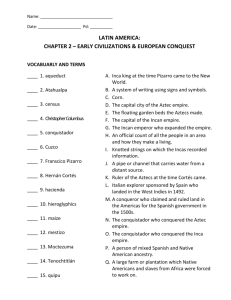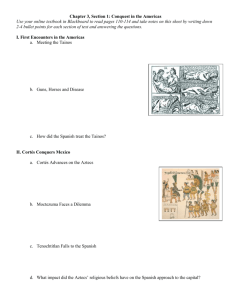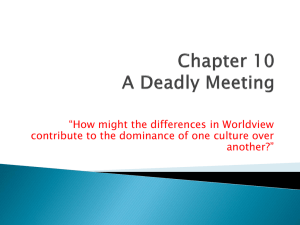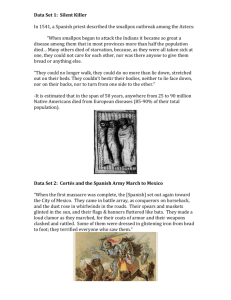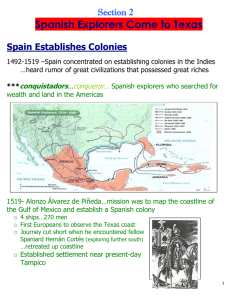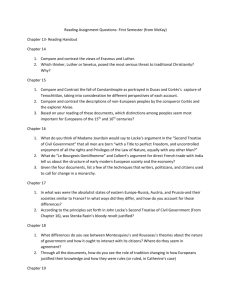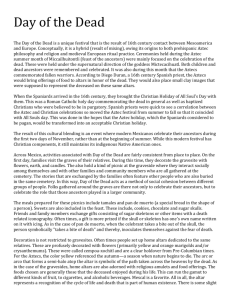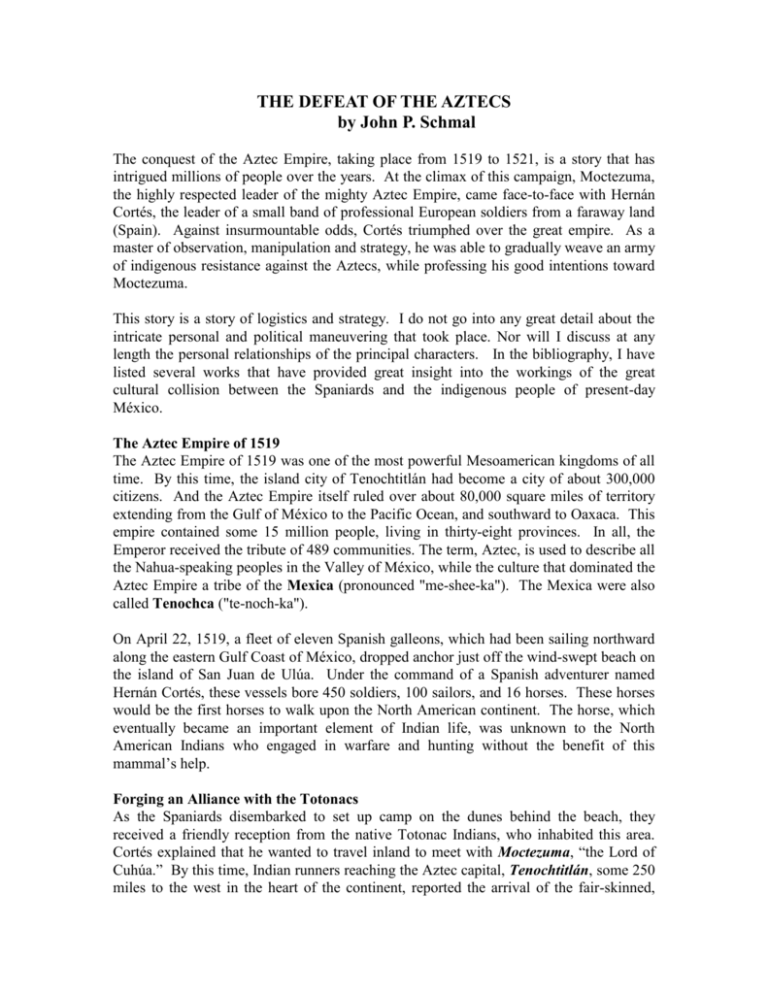
THE DEFEAT OF THE AZTECS
by John P. Schmal
The conquest of the Aztec Empire, taking place from 1519 to 1521, is a story that has
intrigued millions of people over the years. At the climax of this campaign, Moctezuma,
the highly respected leader of the mighty Aztec Empire, came face-to-face with Hernán
Cortés, the leader of a small band of professional European soldiers from a faraway land
(Spain). Against insurmountable odds, Cortés triumphed over the great empire. As a
master of observation, manipulation and strategy, he was able to gradually weave an army
of indigenous resistance against the Aztecs, while professing his good intentions toward
Moctezuma.
This story is a story of logistics and strategy. I do not go into any great detail about the
intricate personal and political maneuvering that took place. Nor will I discuss at any
length the personal relationships of the principal characters. In the bibliography, I have
listed several works that have provided great insight into the workings of the great
cultural collision between the Spaniards and the indigenous people of present-day
México.
The Aztec Empire of 1519
The Aztec Empire of 1519 was one of the most powerful Mesoamerican kingdoms of all
time. By this time, the island city of Tenochtitlán had become a city of about 300,000
citizens. And the Aztec Empire itself ruled over about 80,000 square miles of territory
extending from the Gulf of México to the Pacific Ocean, and southward to Oaxaca. This
empire contained some 15 million people, living in thirty-eight provinces. In all, the
Emperor received the tribute of 489 communities. The term, Aztec, is used to describe all
the Nahua-speaking peoples in the Valley of México, while the culture that dominated the
Aztec Empire a tribe of the Mexica (pronounced "me-shee-ka"). The Mexica were also
called Tenochca ("te-noch-ka").
On April 22, 1519, a fleet of eleven Spanish galleons, which had been sailing northward
along the eastern Gulf Coast of México, dropped anchor just off the wind-swept beach on
the island of San Juan de Ulúa. Under the command of a Spanish adventurer named
Hernán Cortés, these vessels bore 450 soldiers, 100 sailors, and 16 horses. These horses
would be the first horses to walk upon the North American continent. The horse, which
eventually became an important element of Indian life, was unknown to the North
American Indians who engaged in warfare and hunting without the benefit of this
mammal’s help.
Forging an Alliance with the Totonacs
As the Spaniards disembarked to set up camp on the dunes behind the beach, they
received a friendly reception from the native Totonac Indians, who inhabited this area.
Cortés explained that he wanted to travel inland to meet with Moctezuma, “the Lord of
Cuhúa.” By this time, Indian runners reaching the Aztec capital, Tenochtitlán, some 250
miles to the west in the heart of the continent, reported the arrival of the fair-skinned,
bearded strangers and their fearsome “man-beasts” (cavalry).
On June 7, 1519, Cortés led his forces northward to the coastal town Cempoala. As they
approached the town, the Totonac Indians started bringing the Spaniards food and gifts.
Cortés had heard that the cacique (chief) of the Totonacs, Tlacochcalcatl, who reigned
over this area, was an enemy of the Emperor Moctezuma. But the chief was very obese
and not able to move around freely. For this reason, he could not come to greet the
Spanish force in person.
The coastal city-state of Cempoala, presently under Aztec domination, was made up of
some fifty towns. The town of Cempoala itself contained some 14,000 inhabitants. The
townspeople gave the Spanish soldiers a very warm reception and Cacique Tlacochcalcatl
met with Cortés. The chief of the Totonacs, writes Dr. Marrin, complained that the Aztec
“tribute collectors were picking the country clean… like hungry coyotes.” And each year,
the Totonacs were forced to send hundreds of children to the altars of Tenochtitlán for
sacrifice. For this tribute, the hatred of the Totonacs for the Mexica ran deep. For this
reason, Tlacochcalcatl forged an alliance with Cortés.
The Spaniards helped the Totonacs to expel Moctezuma’s tribute-collectors who
apparently fled to a Mexica garrison at Tizapancingo, about twenty miles to the
southwest. With a full force of Spaniards, 16 horses, and Totonacs, Cortés seized control
of the town. The seizure of this town had a profound effect on both the Spaniards and
Totonacs. “The speed of this victory greatly impressed the Totonacs and naturally had the
effect of extending their rebellion,” writes Professor Hugo Thomas in Conquest:
Montezuma, Cortés, and the Fall of Old México, “It also made Cortés even more selfconfident; for it suggested to him and to his captains that the Mexica, despite their fame,
had no special military qualities, no secret weapons, and little discipline.”
The Cempoalans helped Cortés and his men establish a base on the shore. On June 28,
1519, Cortés formally gave this town the name La Villa Rica de la Vera Cruz (The Rich
Town of the True Cross). At this point, Cortés decided to lead his troops westward into
the interior of the continent to find and meet with Moctezuma. Cacique Tlacochcalcatl
warned Cortés that, on his journey inland, he would confront the people of Tlaxcala and
Huexotzinco, two provinces that hated the Mexica equally. With the help of Totonac
guides, Cortés planned his march through territory that might represent fertile ground for
more alliances.
On August 8, Cortés assembled his army for the expedition inland. He had a force of 300
Spanish soldiers, 150 Cuban Indian servants, 800 Cempoalans and other Totonacs led by
a chief named Mamexi. They also had 15 horses, reserved exclusively for the captains of
the army. The Spanish army was thus beefed up with more than a thousand native
warriors plus 200 porters. With a small party of soldiers and sailors left to hold the fort at
Vera Cruz, Cortés commenced the hazardous journey towards the Aztec capital.
Just as they approached the next town, Jalapa, word arrived from the coast that four
Spanish ships under the command of Alonso Alvarez de Pineda had arrived at the coast.
With a force of one hundred men, Cortés quickly returned to the coast to meet the new
arrivals. Although the ships did not arrive with good intent toward Cortés, he had them
arrested and then persuaded them to join his army. Cortés then set off to join and
reassemble his army.
The Journey Inland
Without a way to retreat, on August 16, 1519, the expedition started. In addition to the
Spaniards, there were forty Cempoalan warrior chiefs and 200 Indians to drag the cannon
and carry the supplies. The men were accustomed to the hot climate of the coast, but they
suffered immensely from the cold of the mountains, the rain, and the hail. Although
Cortés asked for peace and friendship, and permission to cross their land on the way to
México, the Tlaxcalan Indians refused.
Finally, on August 16, 1519, as his expedition prepared to move inland from Cempoala,
Hernán Cortés mustered an army of 400 Spanish soldiers, 15 horses, 1,300 Indian
warriors, seven pieces of artillery, and a thousand tamanes (porters), who helped transport
baggage and guns across the land. About 150 of the porters were Cuban Indian servants
who were brought along from Cuba. The force brought along many dogs that had been
well-trained to fight. The distance from Cempoala to Tenochtitlán is 250 miles, as the
crow flies. A fairly large force of 150 Spanish soldiers and sailors and two horses under
the command Juan de Escalante stayed at the garrison at Villa Rica de Vera Cruz.
Roughly 100 soldiers remained in Villa Rica under the command of Gonzalo Sandoval.
On the road ahead, the allied force faced many obstacles. Shortly after reaching Jalapa, a
short distance inland from Cempoala, the altitude of the land rose sharply to 6,000 feet,
transforming the climate from tropical to temperate. As they advanced inland, they
moved through territory that was firmly in the control of the Mexica. On August 24, the
Spanish force arrived in Zautla, where a Mexican garrison was stationed. The chief of the
Zautla, Olintecle, met with Cortés and warmly embraced him. Olintecle was a subject of
the Mexica and may have been given orders by Moctezuma to give food and lodging to
the Spanish force.
After staying in Zautla for about a week, Cortés prepared to move on. He sent four
Cempoalan chiefs ahead to Tlaxcala with instructions to inform them of his approach,
hoping for a peaceful reception. The next stop for the Castilians was Iztaquimaxtitlan, a
mountain town occupied by a Mexica garrison. Several families lived in this town and
once again, on Moctezuma’s insistence, the strangers were well received and given gifts
and lodging.
On their journey out of Iztaquimaxtitlan, the Spaniards came across a large gate, atop
which lay a battlement a foot and a half high. This wall, some twenty paces wide and
nine feet high, ran for several miles across the valley from one mountaintop to another.
This barrier had represented a border which the people of Iztaquimaxtitlan had built to
protect themselves from the fierce Tlaxcalan Indians nearby.
Confronting the Tlaxcalans
Finally, Cortés army reached the Tlaxcalan Republic, which was independent enclave
deep in the heart of the Mexica Empire that had managed to resist Aztec control.
Surrounded on all sides and blockaded by the Aztecs, they had never yielded to them. By
the time that Cortez arrived in the Western Hemisphere, the Tlaxcalan Indians had been
subjected to continuous warfare and human sacrifice for many decades. Because of their
economic isolation, the Tlaxcalans had no cotton with which to make their clothes.
Neither did they have any salt. The salt lakes of Alchichica, not far from Tlaxcala, lay
close by but they could not benefit from this. No feathers or precious stones made their
way into Tlaxcala. They were unable to obtain salt (boiled out of sea water), cotton cloth,
or bird feathers.
Tlaxcala was a small, densely populated province. In 1519, the population was about
150,000. Tlaxcala was actually “confederation of four republics,” ruling over some 200
settlements. Some historians believe that Tenochtitlán could have overwhelmed Tlaxcala
without too much difficulty, and the reason it did not is probably that it wanted a nearby
source of victims for the human sacrifices. Therefore the Aztecs maintained an almost
perpetual state of war with Tlaxcala, but never actually conquered it. Also, the Aztecs
seem to have regarded the frequent battles as a convenient way of testing and training the
young Mexica warriors.
This state of perpetual war was very hateful to the Tlaxcalans and by the time that Cortés
arrived in Tlaxcala, the confederation represented fertile grounds for an anti-Mexica
alliance. However, the Tlaxcalans, very suspicious of the strangers, were in no mood to
accommodate the Spaniards and their Indian allies.
After a brief skirmish along the Tlaxcalan frontier, the Spaniards were guaranteed
passage through the Tlaxcalan Republic. However, on August 31, at a point ten miles
into Tlaxcalan territory, Cortés’ army encountered a hostile force of at least 30,000
Tlaxcalans. Despite the tremendous size of the army, the Spaniards managed to fend
them off. Unlike other Indians, the Tlaxcalans seemed to have no fear of the horses and
killed two of them. That night, the Spaniards, exhausted from their battle, rested in the
open, some twenty miles from the capital city of Tlaxcala.
In the next battle, Cortés claimed that he faced a Tlaxcalan army of 149,000 warriors. In
this battle, some sixty Spaniards and several horses were wounded by the enemy. But, on
the following day, Cortés led a punitive expedition, burning some ten Tlaxcalan towns
(with a total population of over 3,000). Many Indians were killed in this campaign. After
a third day of battles, the Spaniards had lost 45 men who died in battle, died of wounds or
succumbed to disease.
On September 5, the Spaniards and their Totonac allies were ambushed by an army of
50,000 Tlaxcalan warriors. The Tlaxcalan king, Xicotenga, and his council had hoped
that this attack would rid them of the invaders. However, with their advanced technology
and tactical advantages, the Spaniards were able to turn the tide against the Tlaxcalans
and defeat them. Subsequent battles fought during September also ended in Spanish
victory.
Alliance with the Tlaxcalans
Watching the Spaniards prove themselves in battle, King Xicotenga was very impressed
and decided to allow Cortés’ army to pass through the confederation. As the Spaniards
approached the Tlaxcalan capital on September 18, the Spanish soldiers were welcomed
into the town as if they were heroes. For twenty days, Cortés and his army stayed in
Tlaxcala. As his men recovered from their wounds, Cortés forged a relationship with
Xicotenga and other Tlaxcalan leaders. He found that he was now over halfway from the
Gulf of México to Tenochtitlán.
Almost immediately, Xicotenga saw in Cortés a powerful ally who could help the
Tlaxcalans destroy the Mexica. Cortés, for his part, told Xicotenga that he was opposed
only to the Aztec Empire and that there would be a place for Tlaxcala in Spanishdominated México.
Within a very short time, the Tlaxcalans would become the most loyal native allies of the
Spaniards. Their allegiance with the Europeans would be an enduring partnership, lasting
several centuries. The Tlaxcalans were able to provide the Cortés with valuable
information about the Mexica capital, Tenochtitlán. Tlaxcalans who had visited the great
city in the past were able to draw pictures of the city’s layout, as well as its bridges,
causeways and canals. Soon the Spaniards would have a good idea of the layout of the
capital and of the fighting style of the Aztec warriors.
On October 23, 1519, Cortés and his army of European mercenaries and indigenous
warriors left the Tlaxcalan capital. A thousand Tlaxcalan warriors had been added to the
ranks of Cortés force. While Indian laborers carried the cannon and baggage in the center
of the formation, Tlaxcalan warriors and Spanish horsemen marched along the flanks and
with the rear guard. Although Xicotenga had offered him many more warriors, Cortés did
not want a large force of Tlaxcalans that might frighten or enrage the Mexica.
As Cortés traveled westward through mountain towns and villages, many of the Indians
living along this path told him of their cruel treatment at the hands of the Aztec overlords.
Through these meetings, Cortés began to understand the depth of this hatred and fear. He
also recognized that many of these people would be potential allies in a showdown with
the Mexica.
Cholula
Cholula, twenty-five miles east of Tlaxcala, was a city of almost 60,000 houses and 430
temples and pyramids. If necessary, the Cholulans could muster together some 25,000
men for war out of a possible total population of 180,000. Xicotenga had warned Cortés
that the Cholulans were mere pawns of Moctezuma and the Aztec hierarchy and advised
against marching through their territory. But Cortés decided that to advance in this
direction regardless of Xicotenga’s admonition.
As the army approached the Cholulan capital, they were greeted by the caciques and
given a place to stay. Although the Spanish and indigenous accounts differ on what
happened, all agree that a great massacre followed. Through his interpreter, Doña
Marina, Cortés had apparently learned of a Cholulan conspiracy sponsored by
Moctezuma to ambush and slaughter the Spaniards. Expecting an ambush, Cortés
launched a preemptive strike on the Cholulans after having called a meeting of the
Cholulan nobles in the courtyard of the temple of Quetzalcóatl. After a confrontation
with the Cholulans about their intentions towards the Spanish, Cortés issued an order for
the lords to be killed. Quickly and with little mercy, the assembly turned into a full-scale
massacre of 3,000 Cholulan noblemen and warriors. In the meantime, Tlaxcalans and
Totonacs sacked the town.
Quickly, the Cholulan army launched a counterattack against the Spanish forces. After
two hours of battle, both sides agreed to end the fighting. The Cholulans then returned to
their homes, while Cortés’ army marched to the east.
Resumption of the Advance
On November 1, 1519, Cortés assembled his army for the resumption of the march to
Tenochtitlán. At this time, his Totonac allies from Cempoala had to return home.
However, a thousand Tlaxcalans remained in the ranks of his army and they moved on to
higher altitudes. On November 2, Cortés forces moved through a mountain pass that lay
13,000 feet above sea level. From this path, the Spaniards could see the smoking volcano
Popocatepetl (Smoking Mountain) and Ixtaccihuatl (Mountain of White Woman), which
reach 17,887 feet and 17,000 feet, respectively.
From the mountain pass, the Spaniards witnessed for the first time the great splendor of
Tenochtitlán as it spread out on the valley floor. Before long, the mountain pass, with the
great Valley of México in full view, descended to lower altitudes, eventually bringing
Cortés and his forces to an altitude of 7,400 above sea level along the valley floor. As
they made their way to Tenochtitlán, the Spaniards met with another tribe of
Mesoamericans. The King of Texcoco welcomed the Spaniards into his own and
provided his guests with gifts, food, and assistance. Soon after hearing about the
Christian religion, many Texcocans, including the king, decided to convert to
Catholicism. Before continuing on to the capital, the Spaniards performed several
religious services, baptizing the king and other Texcocan nobles.
The Meeting with Moctezuma
On the road to the capital, the army passed through hamlets where they were offered
generous bribes from Moctezuma's emissaries to turn back. When Cortés failed to accept
the bribes, Moctezuma sent his nephew to welcome four hundred Spaniards and their
entourage of 7,000 Tlaxcalan warriors to Tenochtitlán. Finally, on November 8, 1519,
the army reached Xoloco, just outside of Tenochtitlán, where they were greeted by
hundreds of emissaries of Moctezuma. As they were brought into the city, the Spaniards
stared in awe at the architectural precision of the city. Filing across the southern
causeway of the capital, Cortés and his men were greeted with much ceremony by a
retinue of lords and nobles headed by Moctezuma himself.
The Spaniards were housed in the ancient palace of Atzayacatl, the emperor's father. The
wary Moctezuma made great efforts to play the perfect host, showing his unwanted guests
around the city and entertaining them with splendid banquets. Some researchers believe
that the Aztecs may have thought that the Spaniards were gods or godlike creatures. They
also noticed heard about the devastation that took place when the Spaniards won a battle.
In any event, they were at least curious to see these strangers who had marched so many
miles and fought so many battles against various indigenous groups along the way. In
War and Society in Ancient Mesoamerica, the author Ross Hassig points out that “the
Spaniards did not [initially] present themselves as a hostile force.” In fact, the arrival of
the Spaniards and their indigenous allies coincided with the harvest when Aztec soldiers
were unavailable and unprepared for war.
After several days of negotiations and touring, Cortés and his officers took Moctezuma as
a hostage. Bringing the King to his barracks, Cortés persuaded him to dispatch
messengers to the surrounding communities to collect gold and silver, part of which was
sent to the Spanish monarch in the name of Moctezuma and part of which was divided
among Cortés’ troops. Moctezuma’s imprisonment continued for eight months.
Arrival of Narvaez
On April 19, 1520, more ships appeared off the coast of México. The governor of Cuba
had sent soldiers under Panfilo de Narvaez to arrest Captain-General Cortés for
insubordination. Leaving Captain Pedro de Alvarado in charge of his troops, Cortés
quickly departed from Tenochtitlán with 266 Spanish soldiers to confront the newlyarrived Spanish force on the Gulf Coast. Although Narvaez’s troops outnumbered Cortés
by three to one, Cortés and his small army defeated Narvaez in a battle near Veracruz.
After this battle, most of Narvaez's troops joined Cortés who promised them a share of
the spoils when Tenochtitlán was brought under Spanish control.
When Cortés returned to Tenochtitlán, he found out that Pedro de Alvarado had provoked
an open revolt by massacring 600 Aztec nobles during the Feast of Huitzilopochtli.
Fighting quickly broke out in full force the day after Cortés returned, and the sheer
numbers of the Aztec army overwhelmed the Captain-General's army, which numbered
only 1,250 Spaniards and 8,000 Mexican warriors. His army was forced to retreat back
into the barracks but set hundreds of homes on fire before doing so.
The Death of Moctezuma
As the Indians besieged the palace, Cortés ordered Moctezuma to tell his subjects to
disperse. Not only did they refuse but the shower of stones they directed against their
captive emperor caused injuries that resulted in his death. The hail of stones began when
a nobleman defiantly brandished a javelin at Moctezuma. Moctezuma was succeeded as
emperor by Cuitlahuac. Moctezuma had been intimidated by Cortés because he believed
the Spaniards were representatives of the bearded, fair- skinned god Quetzalcoatl.
Cuitlahuac never believed the legend and set out to organize a determined resistance to
the Spanish forces. Though he only ruled four months before succumbing to smallpox,
Cuitlahuac drove Cortés's men out of Tenochtitlán during the famous Noche Triste ("sad
night") of July 1, 1520, depending on which historian you read.
Flight from Tenochtitlán
Cortés and his men were besieged in Tenochtitlán, and on July 1, 1520, Cortés attempted
to break out of the city and cross the lake to the mainland by marching down one of the
causeways. As the force left the palace at midnight, Cortés had some 1,250 Spanish
soldiers and at least 5,000 Tlaxcalan warriors. They had fifty hostages, including Aztec
nobles and two of Moctezuma’s daughters.
While he was crossing the bridge leaving the city, the Aztecs fell upon the army and
inflicted heavy damage. In the disorder, Spanish soldiers who had been too greedy and
filled their pockets with gold were pushed into Lake Texcoco and drowned. The army
managed to attain a place of relative safety on a hill past the nearby town of Tlacopan but
not without losing about 450 Spanish and 2,000 Mexican soldiers from their ranks.
Plagued by hunger, disease, and the pursuing Aztecs, Cortés’ army fled to Tlaxcala to
obtain reinforcements. On July 8, the army came upon a legion of nearly 200,000 Aztecs
sent by Cuitlahuac, Moctezuma's brother and successor. There, at the battle of Otumba,
the Spanish managed a smashing victory that dissuaded the Aztecs from pursuing the
Spaniards and their allies any farther.
By the end of the battle, Díaz wrote, 850 Spaniards, 4,000 Tlaxcalans were lost. Only
twenty-four of the 95 horses survived the exodus. All the cannon and nearly all the
muskets and crossbows had been lost. None of the Aztec prisoners survived. Even with
the many reinforcements that Cortés had brought from the coast, this left only 420 men
and 17 horses. All the survivors, including Cortés, were wounded, and very few firearms
or ammunition were left. As the battered army approached Tlaxcala, they were greeted
by their Indian allies and given refuge.
Reflections on a Narrow Escape
“Reviewing their narrow escape,” writes Michael C. Meyer, “many of the Spanish
veterans wanted nothing more to do with the Aztecs. It required all of Cortés’ force of
personality and subtle blandishments to prevent mass defections and rebellion among his
men. Cortés, who seems never to have wavered in his determination to retake
Tenochtitlán, began to lay plans for the return.”
It goes without saying that the Spaniards would not have survived their ordeal without the
help of their Tlaxcalan allies. The Tlaxcalan chiefs called on Cortés during this dismal
time and laid out their conditions for further assistance. The Tlaxcalans requested
“perpetual exemption from tribute of any sort, a share of the spoils, and control of two
provinces that bordered their land.” Cortés agreed to these conditions and, as the author
Richard Lee Marks wrote, “Spain substantially kept its promise” to the Tlaxcalans “and
exempted them from tribute for the entire period of the Spanish rule in México, nearly
three hundred years.”
Smallpox
The Spaniards, however, also received more important support from another, unexpected
ally. “While the Spaniards rested and recuperated” in Tlaxcala, wrote Richard Lee
Marks, “it occurred to Cortés and his men to wonder why the great armies from
Tenochtitlán were not pursuing them.” The Aztecs had not attacked or laid siege to
Tlaxcala, giving the Spaniards and Tlaxcalans precious time to heal and recover from
their catastrophic defeat. Later, Cortés would learn that an epidemic of smallpox had
devastated Tenochtitlán.
While the Spaniards were in Tlaxcala, a great plague broke out here in Tenochtitlán. It
began to spread during the thirteenth month and lasted for seventy days, striking
everywhere in the city and killing a vast number of our people. Sores erupted on our
faces, our breasts, our bellies; we were covered with agonizing sores from head to foot.
At the same time in the Aztec capital, a smallpox epidemic began that killed Cuitlahuac
and immobilized much of the population. To replace the king, the caciques of
Tenochtitlán chose Cuahtemoc, a nephew of Moctezuma and a brilliant military leader
who fiercely believed that his Aztec army, with the help of Huitzilopochtli, could defeat
the invaders.
The Aztecs, convinced that the Spaniards would never return to Tenochtitlán, celebrated
their fiestas again in the traditional manner, and Cuitlahuac was elected king to succeed
his brother Moctezuma.
Brought to the shores of México by an African sailor, “the disease had spread with
amazing rapidity through the coastal tribes and up into the highland.” The disease spread
quickly among the Indians, according to Marks, because they “were in the habit of
bathing to alleviate almost any ailment that afflicted them. These baths were either
communal or the same bathing water was used consecutively by many. But after
someone with an open smallpox sore entered the bath, the disease was transmitted to
everyone who followed.” The Spaniards, however, never bathed. Although they
occasionally washed off the dirt and blood when they had to, “they believed that bathing
per se was weakening.” And the Tlaxcalans, “always in a state of semi-siege,” were not
yet exposed to the smallpox.
The illness was so dreadful that no one could walk or move. The sick were so utterly
helpless that they could only lie on their beds like corpses, unable to move their limbs or
even their heads. They could not lie face down or roll from one side to the other. If they
did move their bodies, they screamed with pain.
A great many died from this plague, and many others died of hunger. They could not
getup to search for food, and everyone else was too sick to care for them, so they starved
to death in their beds.
Some people came down with a milder form of the disease; they suffered less than the
others and made a good recovery. But they could not escape entirely. Their looks were
ravaged, for wherever a sore broke out, it gouged an ugly pockmark in the skin. And a
few of the survivors were left completely blind.
The illness was so dreadful that no one could walk or move. The sick were so utterly
helpless that they could only lie on their beds like corpses, unable to move their limbs or
even their heads. They could not lie face down or roll from one side to the other. If they
did move their bodies, they screamed with pain. A great many died from this plague, and
many others died of hunger. They could not getup to search for food, and everyone else
was too sick to care for them, so they starved to death in their beds.
The Captain-General's army left Tlaxcala on December 26, 1520 on its march to the
Aztec capital. Cortés’ army had been completely rebuilt. With his army of 600 Spanish
soldiers and between 110,000 and 150,000 Mexican warriors, Cortés intended to occupy
the city of Texcoco and blockade Tenochtitlán from there. With the city sufficiently
weakened, his army would cross the lake on thirteen brigantines constructed for this
purpose by the Spaniards.
Into the Valley of México
In January 1521 Cortés once again led his force into the Valley of México. They staged a
series of raids throughout the countryside and took the Aztec stronghold at Texcoco, from
whence they could launch the newly built fleet. The occupation of Texcoco was done
without conflict, and from there the army destroyed the town of Iztapalapan and
massacred its residents, which sent shockwaves throughout the surrounding area. Having
witnesses the military and technological advantages of the Spanish forces, many caciques
who had avoided the Spaniards now decided to join their forces with Cortés’ army.
In March 1521, Cortés began with a reconnaissance in force to gain control of
communities in the Valley of México adjacent to Tenochtitlán. He got as far as the
neighboring settlement of Tacuba before Cuauhtemoc drove the Spaniards and Tlaxcalans
back in a determined land and naval counterattack. Then the tide turned again when
reinforcements arrived from Hispaniola. While he was preparing a fleet of small
brigantines to control the lake during his assault, Cortés was reinforced by fresh troops
from Spain.
At the time of the assault on Tenochtitlán, Cortés had gained an additional 200 Spanish
soldiers and 50,000 Tlaxcalans. He had over 900 Spaniards, including 18 musketeers and
crossbowmen. The cavalry had been beefed up with some ninety horses and their riders.
The artillery included fifteen small bronze guns and heavy iron cannon-wall smashers.
Within the ranks of this huge army were at least 50,000 Tlaxcalans, and thousands of
other supporters. Seventy thousand Indian laborers carried supplies, built roads and
carried on our auxiliary chores.
In April 1521 he had 86 horsemen, 118 crossbowmen and harquebusiers, 700 sword and
pike men, as well as 18 cannons. In addition he had as many as 75,000 Tlaxcalan allies. It
was still a stiff task, for the Aztecs numbered at least 250,000 men, and this time he could
not rely on their native superstition to win the fight for him.
The stage was now set for the final assault. The brigantines were launched April 28,
1521, and land operations began a few days later. Cuauhtemoc, realizing that his
horseless troops were no match for the Spaniards in open country, decided that it would
be better to wage urban warfare against the enemy. Turning Tenochtitlán into an Aztec
Stalingrad, he defeated the initial Spanish assault on the city and drove the enemy back to
their siege lines outside the gates.
The Assault on Tenochtitlán
To triumphant shouts of 'Castile' and 'Santiago', and to a cacophony of native instruments
Cortés launched his brigantines on the lake and began his assault on Tenochtitlán. With
his headquarters located at Tlacopan, Cortés had divided his forces into three sections: his
deputy, Pedro de Alvarado, took 30 horses, 18 crossbowmen, 150 infantry and 25,000
Tlaxcalans and advanced down the causeway that ran from Tacuba in the northwest;
Cristóbal de Olid, with 33 horse, 18 crossbowmen, 150 infantry and 25,000 Tlaxcalans
advanced on the causeway from Coyoacan in the southwest; and Gonzalo de Sandoval,
with 24 cavalry, 4 harquebusiers, 13 crossbowmen, 150 infantry and 30,000 Indian allies,
advanced on the causeway from Iztapalapan in the southeast.
Cortés himself commanded the brigantines in which the rest of the Spanish forces crossbowmen and harquebusiers - were placed. It was a carefully planned exercise,
showing a thorough appreciation of Aztec strengths and weaknesses. Cortés even left one
causeway free, so that the Aztecs would have an escape route and would not fight to the
death. In the event, few took this route; most preferred to die with their city.
In preparation for the attack, the Captain-General destroyed the aqueducts that supplied
water to the capital with only ineffectual Aztec resistance. Two of the three divisions of
the army attempted to attack the city across the causeway but met strong Aztec forces and
were forced back. The third division, under Cortés, boarded the brigantines and patrolled
the water, completely overwhelming the Aztecs' canoes and temporarily gaining control
of Lake Texcoco.
The fighting raged back and forth as the Spaniards and their allies (now joined by 50,000
Texcocoans and later 150,000 of the Aztecs themselves) attempted to break the Aztec
defense from both land and sea. They did so a few times but were steadily pushed back by
the now starving inhabitants of Tenochtitlán. Cortés was increasingly distressed at his
army's inability to break the Aztec spirit.
After nearly three months of such fighting, the Captain-General ordered a full-scale
assault on Tenochtitlán. All three divisions crossed the causeway backed up by the
brigantines and a fleet of Mexican canoes. Each division marched down one of the
principal boulevards that all converged in Tlatelolco Square. They steadily pushed the
Aztecs backwards; and when the Aztec king sounded the retreat, the captains pushed on
towards their fleeing prey. When Cuahtemoc's horn sounded again, the Aztecs turned
around and fell on the Spaniards, capturing sixty-two of them and sacrificing them in
front of the Spaniards in an attempt to destroy their morale. Cortés ordered the retreat.
Five days passed, and famine and disease had devastated the Aztecs. Cortés knew this
and appealed to Cuahtemoc to surrender, but the king felt that dying for one's country
would be better than being enslaved by the Spaniards. He answered in the form of an
attack on the entrenched army. The Aztecs charged from the walls of the city to meet their
enemy, but were quickly forced into a retreat by the firing of artillery and musketry.
Cortés’ army charged after the Aztecs, forcing them back, until the Spaniards and their
allies controlled around three-quarters of the city. Everywhere they went they left a trail
of destruction--burned or pulled-down homes and temples--regardless of whether or not
there were wounded men, women, or children inside.
Still, the Aztec king refused to surrender. Cortés proposed a banquet at which the two
sides could meet to negotiate, but the king sent his nobles and didn't come himself. The
next morning, Cuahtemoc agreed to meet the Captain-General at the marketplace; but
when Cortés and his entourage arrived, they found the Aztec soldiers waiting for them.
An enormous battle ensued; and both sides took heavy losses, the total number of deaths
in that individual battle numbering more than 40,000.
The Surrender
The next morning, August 13, 1521, Cortés’ army once again marched into the city.
Another battle began, similar in scale to the one the day before, but Cortés ordered a
cease-fire as three canoes were sighted fleeing across the lake. Cuahtemoc, who was
riding in one of the canoes, was apprehended and brought to the Captain-General.
The Aztecs fought valiantly under leadership of the last Aztec emperor, Cuauhtemoc,
whose name translates as "falling eagle" or alternately "setting sun." Ravaged by diseases
introduced by the Spaniards, deprived of fresh water and food supplies from the
mainland, they withstood an 80-day siege, surrendering August 13, 1521, only after their
captured leader grasped the dagger in Cortés' belt and pleaded, "I have done all that I
could
Cortés consoled him and asked him to command his warriors to surrender. Cuahtemoc
immediately climbed onto a high tower and shouted to them to cease fighting, for
everything had fallen to the enemy. Of the 300,000 warriors who had defended the city,
60,000 were left. When they heard their king, they laid down their arms and the nobles
came forward to comfort him.
The siege of Tenochtitlán, according to the histories, paintings and chronicles, lasted
exactly eighty days. Thirty thousand men from the kingdom of Texcoco were killed
during this time, of the more than 200,000 who fought on the side of the Spaniards. Of
the Aztecs, more than 240,000 were killed. Almost all of the nobility perished: there
remained alive only a few lords and knights and the little children. Albert Marrin, the
author of Aztecs and Spaniards: Cortés and the Conquest of México,” writes that “what
had taken centuries to build, would be destroyed in just thirty months.”
Tenochtitlán Becomes México
The conquerors banished the Aztecs from their city and began to clear the city. The
Aztec homes, now in shambles, were torn down and new homes for the conquistadors
were built by reluctant Mexican laborers. Over the next four years, Hernán Cortés was
appointed Governor, Captain-General, and Chief Justice of the province of New Spain.
He passed this time presiding over the reconstruction of Tenochtitlán, which he renamed
México (later México City in the present-day country of México), and bringing colonists
from Spain to make their homes there.
The key to the Spanish conquest of México was the dissension among the different
peoples of the Aztecs' empire. The Mexica overlords had made no attempts to assimilate
the other cultures to their own and thus provided the basis for a full scale revolt against
them which Cortés incited. While the Aztecs were really unable to unify their empire, the
Spanish managed to succeed where their predecessors in the area had failed.
Copyright © 2008 by John P. Schmal. All Rights Reserved.
Sources:
Davies, Nigel. The Aztecs: A History. Norman, Oklahoma: University of Oklahoma,
1980.
Hassig, Ron. Aztec Warfare: Imperial Expansion and Political Control. Norman,
Oklahoma: University of Oklahoma Press, 1988.
Marks, Richard Lee. Cortés: The Great Adventurer and the Fate of Aztec México. New
York: Alfred A. Knopf, 1994.
Meier, Matt S. and Feliciano Rivera. The Chicanos: A History of Mexican Americans.
New York: Hill and Wang, 1972.
Meyer, Michael C. and Sherman, William L. The Course of Mexican History. New York:
Oxford University Press, 1987.
Prescott, William H. History of the Conquest of México, Volume 1. Philadelphia: J.B.
Lippincott and Compnay, 1873.
Smith, Michael E. The Aztecs. Cambridge, Mass.: Blackwell Publishers, Inc., 1996.

